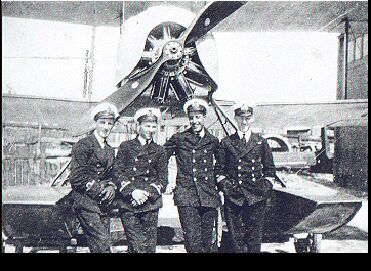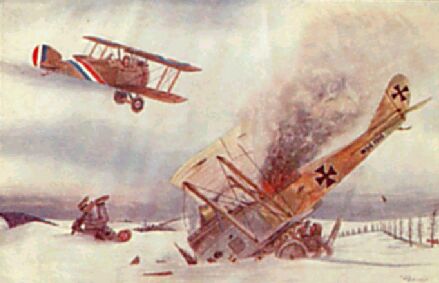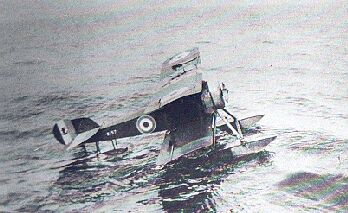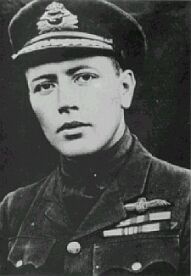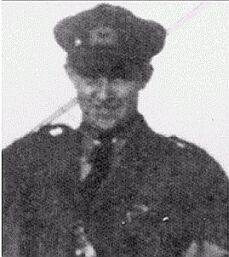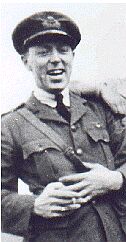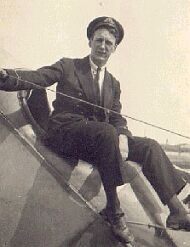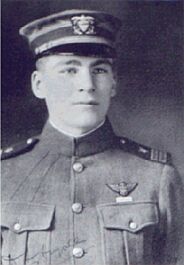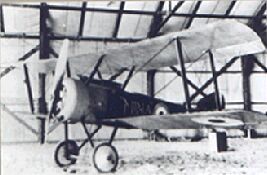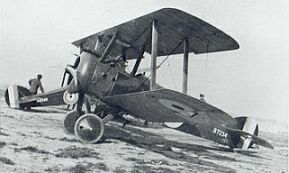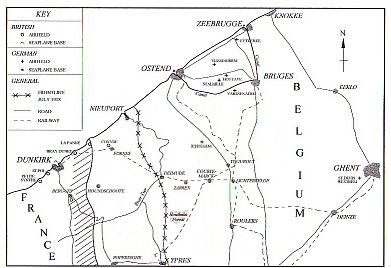Royal Naval Air Service Origins
The First World War
1917 - 1919
The reproduction left is of a drawing by Sqn Cdr R Graham, which was used as the Squadron Christmas Card in 1918.
213 Squadron, Royal Air Force had its origins in the Royal Naval Air Service Seaplane base at Dunkirk. Since 1915 Naval pilots had been providing essential services for the Dover Patrol whose task it was to protect the eastern approaches to the English Channel from German surface raiders and submarines. In addition to all of the natural hazards the Dunkirk seaplanes were confronted by two powerful German seaplane units Seeflug I operating from Zeebrugge and Seeflug II based at Ostend. It soon became clear that the unarmed Short seaplanes used for spotting submarines could not operate without armed escorts.To fill this role initially Sopwith Baby single seat seaplanes were used.
Flt Sub-Lts L H Slatter, P S Fisher and J E Potvin with Flt Lt R Graham standing in front of a Sopwith Baby seaplane at the Dunkirk Seaplane base in the Spring of 1917. Flt Sub-Lt J E Potvin was shot down and killed on 19 June 1917.
Even so the two-seat German Fredrichshafen seaplane and the single-seat Brandenburg KDW still had a marked superiority in speed, rate of climb and manoeuvrability. The Dunkirk seaplanes were also outnumbered.
In June 191 C D R Lambe who commanded the seaplanes at both Dover and Dunkirk proposed a radical solution to the problem suggesting that the fighting seaplanes should be replaced by more advanced land planes. Cdr Lambe's suggestion was agreed and so it was that on 3 July 1917 the Seaplane Defence Flight was born when four pilots from the Seaplane Base at Dunkirk collected four Sopwith Pups from the aircraft depot at Dunkirk and flew them to the nearby airfield at St Pol. The four pilots were Flt Lts R Graham, P S Fisher and G W Price and Flt Sub-Lt L H Slatter.
The unit that was to become 213 Squadron, Royal Air Force had arrived.
Colin Peter Brown was born on 20 December 1898 and educated at Dulwich College, London. He joined the RNAS in June 1917 and after training was posted to the Seaplane Base at Dunkirk. He joined the Squadron on 29 August 1917, and soon proved himself an able and aggressive pilot. He took part in the night attacks on Zeebrugge harbour that preceded the famous raid.
Before leaving the Squadron to go to 5 Group he amassed three hundred and seventy-four hours of combat flying destroying or forcing down out of control fourteen enemy aircraft, eight of which were the much vaunted Fokker DVII, only four of his victories were shared.
During his time with the Squadron he was awarded the DFC and Bar. He remained in the RAF after the war. During the Second World War he served as SASO No 60 Group and at the Air |Ministry. He retired as an Air Vice-Marshal CBE, and died on 19 October 1965.
CAPTAIN COLIN PETER BROWN
Although Ray Collishaw "the Canadian Ace" was the highest scoring pilot to fly with the Squadron, in either war, he in fact only flew with 13 Squadron RNAS for a short period.
In the latter part of 1917 he was sent back to Canada on three months leave after service with Nos 3 and 10 Squadrons RNAS during which he had shot down or destroyed thirty-eight enemy aircraft. At the end of his leave he was posted to 13 Squadron as a Flight commander to re-acclimatise to combat flying and to familiarise himself with the Sopwith Camel.
When Ronnie Graham crashed and was injured in December 1917 Ray Collishaw assumed temporary command of the Squadron until January 1918 when he was posted to command No 3 Squadron, RNAS following Ronnie Graham's return to flying duties.
The Flight that Collishaw commanded while with 10 Squadron RNAS became known as the Black Flight and the aircraft were all given names associated with that colour. He repeated this with 13 Squadron and soon aircraft named Black Cat, Black Prince etc appeared "on deck" the naval expression used for the flight line.
MAJOR R COLLISHAW, RAF, DSO & BAR, DSC, DFC
CAPTAIN G C MACKAY
Born in Toronto on 17 May 1896 George Chisholm Mackay was the most successful of the many excellent Canadian pilots who flew with the Squadron during the First World War. He served with the Squadron 2 November 1917 until 15 September 1918 when he was wounded and taken off the Squadron's strength. During this period, with a break from the middle of June until the middle of August while he was in England, he amassed over three hundred hours of combat flying. During his second period of service with the Squadron he was promoted to Captain and served as a Flight Commander.
He destroyed twelve enemy aircraft, eight of which were shared, and he drove down out of control a further six making him the leading pilot in the number of enemy aircraft destroyed with a total of eighteen.
In June 1918 he was awarded the DFC, he also received the Belgian Order of Leopold and the French Croix de Guerre.
Another of the leading Canadian pilots who flew with the Squadron, John Edmund Greene was born in Winnipeg on 2 July 1894. He joined the RNAS in 1916 and joined 13 Squadron on July 1917, he spent his entire combat service with the Squadron, becoming a flight commander in 1918.
It is noteworthy that of the fifteen enemy aircraft destroyed or forced down out of control only five were shared. Eight of his victories were achieved against the much vaunted Fokker DVII, these victories were scored in early October when the Squadron was supporting the advance of the Belgian Army, some French units and the British Second Army in the final advance that ended the war.
In recognition of his successes he was awarded the DFC.
He was shot down and killed while carrying out low-level straffing attacks on 14 October 1918.
The pictures and Narratives are courtesy of Frank M Leeson
CAPTAIN JOHN EDMUND GREENE
Serving as Commanding Officer from its formation as the Seaplane Defence Flight, RNAS on 3rd July 1917 until the end of the First World War as 213 Squadron, RAF Ronnie Graham's was the decisive influence that moulded the Squadron during its first period of combat as a fighter squadron.
Born in Japan on 19th July 1896 he was studying medicine when hostilities commenced. In 1915 he joined the Royal Naval Division and in September of that year transferred into the Royal Naval Air Service as a Flight Sub-Lieutenant.
In 1916 after completing his flying training he commenced his operational flying at the Dover Seaplane Base. In 1917 he moved with his unit to Dunkirk, flying the Sopwith Baby to provide air cover for the North Sea Fleet and the Belgium Coast Barrage.
On 3rd July 1917 as a Flight Lieutenant he was the most senior of the four original pilots who formed the Seaplane Defence Flight based at St Pol, a small airfield located on the outskirts of Dunkirk. Shortly after assuming command he was promoted to Flight Commander and awarded the Distinguished Service Cross.
Subsequently as Squadron Commander, and then as Major, on creation of the Royal Air Force on 1st April 1918, he continued to command the Squadron until after the Armistice was signed. With the war finally over he returned to the UK to take command of 233 Squadron based at Guston Road airfield just outside Dover.
During his service in France he shot down or destroyed five enemy aircraft including two shared. In addition to his DSO, DSC & Bar and DFC he was also awarded the Croix de Guerre and the Belgian Order of the Crown. In the Second World War he served on the staff of Bomber Command. He retired from the Royal Air Force with the rank of Air Vice-Marshal, CB, CBE.
MAJOR R GRAHAM, RAF, DSO, DSC & Bar, DFC
Leonard Horatio Slatter was born on 8 December 1896, and educated in South Africa where he became a civil engineer. Before joining the RNAS in 1916 as an observer he had served as a dispatch rider in an armoured car unit. As an observer he flew over one hundred hours in Short Seaplanes from the Dunkirk Seaplane Base. After training as a pilot he returned to Dunkirk in February 1917.
Slatter was one of the original four pilots who formed the Seaplane Defence Flight at St Pol on 3 July 1917. In the following twelve months he destroyed or forced down out of control six enemy aircraft, plus a Gotha bomber returning from a raid over England which he engaged at night in a Sopwith Pup, and which was forced to land.
During this period he was awarded the DSC and bar. In August 1918 while serving with 4 ASD-Pilot Pool-he shot down a Halberstadt two-seater-his seventh victory-for which he was awarded the DFC. He remained in the RAF and during the Second World War commanded 15 Group Coastal Command before becoming Commander-in-Chief Coastal Command in 1945 with the rank of Air Marshal, he was awarded the CBE in 1919
FLIGHT SUB-LIEUTENANT L H SLATTER
The First Yale Unit, which contributed significantly to the early growth of US naval aviation, was an unofficial privately sponsored organisation of college students formed in 1916 to produce aviators for the US Navy.
A product of this unit Dave Ingalls received his basic flying training in America, before completing it at the RFC training school at Gosport. He arrived at the US naval Station at Dunkirk on 21 March 1918, the very day the Germans launched their massive spring offensive known as the "Kaiserschlacht".
During the two short periods he flew with the Squadron he became the first US naval pilot to be awarded the DFC, and one of the first to shoot down or destroy five enemy aircraft. He was awarded the DFC for his part in the Squadron raid on the German airfield at Uytkerke on 16th September 1918. As an Acting Flight Commander he led a flight of five aircraft over the airfield and scored direct hits on the hangars assigned as targets. In his recommendation for the award Major Graham wrote "His keenness, courage and utter disregard of danger are exceptional and are an example to all. .
LIEUTENANT D S INGALLS, USNRF.
He is one of the finest men the Squadron has ever had." Following a successful career in the US Navy he retired as Rear Admiral D S Ingalls, DSM, DFC.
The Sopwith Pup a fast agile scout aeroplane made its first appearance early in 1916. Known initially to the RFC as the Sopwith Scout, and to the RNAS as the Type 9901, it soon became universally known as the Pup. It was of standard wood and fabric construction, powered by an 80h.p. le Rhone rotary engine and armed with a single Vickers machine gun mounted on the decking in front of the cockpit firing through the propeller arc synchronised with a Sopwith-Kauper gear.
A comparatively small aircraft its overall dimensions were length 19ft 3ins (5.8m), height 9ft 5ins (2.7m0 and wingspan 26ft 6ins (8m).
Sopwith Pups with the following registration numbers were flown by the Seaplane Defence Flight from July 1917 until the end of September 1917. 9744, 9900, 9916, 9929, N6171, N6179, N6203, N6206, N6335, N6345, N6348, N6349, N6368, N6435, N6436, N6437, N6459, N6478.
Sopwith Pup " Mina" Flown by Flt. Sub- Lt L H Slatter
The Aircraft
The Pilots
The Sopwith Camel came into general squadron service in December 1916; the Seaplane Defence Squadron was re-equipped with Camels in late September 1917.
The most famous of T O M Sopwith's single seat scout/fighters the Camel was, while conventional in construction, an inspired design. The aircraft's outstanding manoeuvrability, its primary feature, was ensured by grouping the engine, the guns and the pilot in the short forepart of the fuselage around the centre of gravity. The Camel's swift response to the controls and its pronounced sensitivity made it an ideal fighting machine. However for new pilots the considerable torque engendered by the engine made it difficult to handle for the unwary.
The majority of the Camels flown by the RNAS, and those flown by the Squadron, were powered by the Bentley rotary engine. The two Vickers machine guns were mounted in the coaming in front of the cockpit and thus easily under the direct control of the pilot. It was the "hump" in the coaming housing these guns that gave the aircraft its somewhat inappropriate name.
Sopwith Pup
Sopwith Camel
Sopwith Camel B7234 frequently flown by Flt Sub-Lt R I Whitely in the Spring of 1918.
The Sopwith Camel has the distinction of being involved in the destruction of more enemy aircraft than any other British scout/fighter in the First World War.
Sopwith Camels with the following registration numbers were flown by the Seaplane Defence Squadron, No 3 Squadron, RNAS and No 213 Squadron, RAF from late September 1917 until the Squadron's disbandment in December 1919.
B3773, B3774, B3782, B3793, B3794, B3894, B3909, B3921, B3935, B3936*, B5687, B6202, B6212, B6239, B6240, B6357*, B6358+, B6378, B6390*, B6391*, B6397*, B6399, B6400, B6401, B6407, B6410, B64488, B7175+, B7186+, B7192+, B7202*, B7215+, B7226, B7228*, B7229*, B7232*, B7233*, B7234+, B7245+, B7252+, B72548, B7270, B7271+, B7272, B7274+, B7276, BC65+, C738, C76, C200, D1871+, D3326+, D3331*, D3333*, D3341+, D3342*, D3351*, D3356+, D3358, D3360, D3364+, D3369+, D3372+, D3378+, D3379, D3380+, D3383, D3397, D3398, D3399*, D3400, D3407+, D3409+, D3411*, D3412+, D3413, D9490, D9627*, D9628*, D9647, D9648, D9649, D9675, D9677, D96788, E1406, E4385+, E4397, E4406, E441999, E4421*, F3110, F3114*, F3118, F3120+, F3121, F3122*, F3126*, F3130, F3136, F3138, F3238, F3239*, F3240*, F3944, F3945, F3948+, F3950, F3951*, F3965, F3966, F3967 F5913*, F5966+, F8502, F8504, F8505, F5805, F8511, F8512, N6335*, N6345, N6348+, N6349+, N6363, N6376.
·* Denotes written off in an accident. + Denotes lost to enemy action.
The Battlefield
The Squadron's "battlefield in the First World War was by to-day's standards of aerial warfare very limited.
In its earliest days as the Seaplane Defence Flight and Seaplane Defence Squadron its main task was the protection of the seaplanes which were spotting for German submarines inshore of the Belgium Coast Barrage. This network of mines and underwater obstructions paralleled the French and Belgian coast about eleven miles offshore from Dunkirk as far as the Dutch Border.
Later when the Squadron operated as a scout squadron its area of operations formed a right-angled triangle. The base of the triangle ran east from the airfield at Bergues as far as, or a little beyond, Roulers, with the hypotenuse running along the coast to Zeebrugge.
This triangle thus formed covered the western end of the Western Front running from just north of Houthulst Forest, north of Ypres, to Nieuport where it reached the North Sea coast.
31st December 1919
Squadron Disbanded
 | ||||||
13 Sqdn RNAS to 213 Squadron RAF
 | ||||
